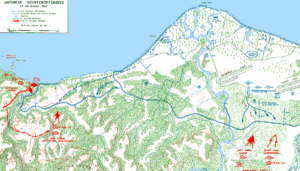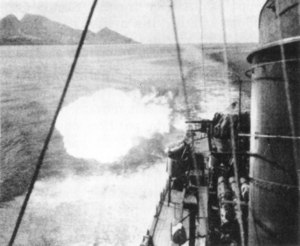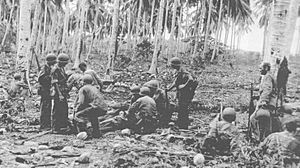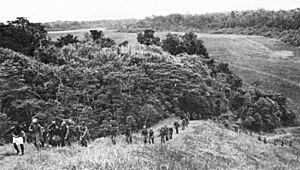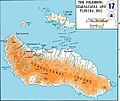Koli Point action facts for kids
Quick facts for kids Koli Point action |
|||||||
|---|---|---|---|---|---|---|---|
| Part of the Pacific Theater of World War II | |||||||
 75 mm pack howitzers of the 11th U.S. Marine Regiment fire in support of the operation against Japanese forces around Koli Point. |
|||||||
|
|||||||
| Belligerents | |||||||
| Commanders and leaders | |||||||
| Strength | |||||||
|
3,500
|
2,500–3,500 | ||||||
| Casualties and losses | |||||||
| 40 killed | 450+ killed | ||||||
The Koli Point action was a battle that took place on Guadalcanal from November 3 to 12, 1942. It was part of the larger Guadalcanal campaign during World War II. In this fight, U.S. Marine Corps and U.S. Army troops faced off against the Imperial Japanese Army.
The American forces were led by Major General Alexander Vandegrift. The Japanese forces were under Lieutenant General Harukichi Hyakutake. U.S. Marines from the 7th Marine Regiment and soldiers from the 164th Infantry Regiment attacked Japanese troops. Most of these Japanese soldiers were from the 230th Infantry Regiment, led by Toshinari Shōji.
Shōji's troops had moved to the Koli Point area after their attacks on American defenses failed in late October 1942. During the Koli Point action, American forces tried to surround and destroy Shōji's group. Even though Shōji's unit lost many soldiers, he and most of his men managed to escape. They fled into the jungle of Guadalcanal. Later, a group of U.S. Marine Raiders chased and attacked them as they tried to reach other Japanese positions.
Contents
The Guadalcanal Campaign Begins
On August 7, 1942, Allied forces, mostly from the U.S., landed on Guadalcanal. They also landed on Tulagi and Florida Islands in the Solomon Islands. The goal was to stop Japan from using these islands as bases. These bases could threaten the supply routes between the U.S. and Australia. The Allies also wanted to use the islands as a starting point. Their bigger goal was to cut off the main Japanese base at Rabaul.
The landings surprised the Japanese. By August 8, about 11,000 Allied troops had secured Tulagi. They also took control of an airfield being built at Lunga Point on Guadalcanal. This airfield was later named Henderson Field. Airplanes flying from Henderson Field were called the "Cactus Air Force" (CAF). To protect the airfield, U.S. Marines set up defenses around Lunga Point.
Japan's military leaders ordered the 17th Army to retake Guadalcanal. This army was based at Rabaul and led by Lieutenant-General Harukichi Hyakutake. Starting August 19, Japanese units began arriving on Guadalcanal. Their mission was to drive the Allied forces off the island.
Japanese forces could not use large, slow transport ships. This was because of the threat from CAF planes at Henderson Field. Instead, they used fast warships from Rabaul and the Shortland Islands. These warships, mostly light cruisers or destroyers, could travel to Guadalcanal and back in one night. This reduced their risk of air attacks. However, this method meant soldiers could not bring heavy equipment. They often lacked artillery, vehicles, and enough food and ammunition. These fast warship trips were called the "Tokyo Express" by the Allies.
The first Japanese attempt to recapture Henderson Field failed on August 21. A force of 917 men was defeated in the Battle of the Tenaru. The next attempt was from September 12 to 14. About 6,000 soldiers were defeated in the Battle of Edson's Ridge. After this defeat, the Japanese troops regrouped west of the Matanikau River.
American forces focused on strengthening their defenses around Lunga Point. On September 18, 4,157 men from the U.S. 7th Marine Regiment arrived. These new troops allowed General Vandegrift to create a strong defense line around the Lunga area.
Vandegrift knew Japanese troops were west of the Matanikau River. He also knew many small groups of Japanese soldiers were scattered between Lunga Point and the Matanikau. So, he decided to send out small groups of Marines to clear the area.
The first U.S. Marine operation against Japanese forces west of the Matanikau failed. Japanese troops pushed them back. In the second operation, a larger force of U.S. Marines crossed the Matanikau River. They attacked newly arrived Japanese forces and caused heavy losses. This forced the Japanese to retreat from their positions east of the Matanikau.
Meanwhile, Major General Millard Harmon, who led U.S. Army forces in the South Pacific, convinced Vice Admiral Robert L. Ghormley that the Marines on Guadalcanal needed more help. So, on October 13, a naval convoy brought 2,837 soldiers. These were from the 164th U.S. Infantry Regiment. They were part of the U.S. Army's Americal Division.
The Battle for Henderson Field
Between October 1 and 17, Japan sent 15,000 more troops to Guadalcanal. This gave Hyakutake about 20,000 soldiers for his next attack. The Japanese had lost their positions east of the Matanikau. So, they decided attacking the U.S. defenses along the coast would be too hard. Hyakutake chose to attack Henderson Field from the south.
His 2nd Division, with about 7,000 soldiers, was ordered to march through the jungle. They would attack the American defenses from the south, near the Lunga River. The 2nd Division was split into three groups.
On October 23, Maruyama's forces struggled through the jungle. They tried to reach the American lines. One of his commanders, Kawaguchi, tried to change the attack plan. He thought the American defenses were weaker elsewhere. Maruyama ordered him to stick to the original plan. When Kawaguchi refused, he was removed from command. Colonel Toshinari Shōji took his place. That evening, Hyakutake delayed the attack to October 24. The Americans did not know Maruyama's forces were approaching.
Finally, late on October 24, Maruyama's forces reached the U.S. Lunga defense line. For two nights, Maruyama's troops launched many direct attacks. They tried to break through positions held by the 1st Battalion, 7th Marines and the U.S. Army's 3rd Battalion, 164th Infantry Regiment. American rifle, machine gun, mortar, and artillery fire caused huge losses for the Japanese. More than 1,500 of Maruyama's soldiers were killed. The Americans lost about 60 men. Shōji's units did not join the attacks. They stayed in place to protect another Japanese flank.
At 8:00 AM on October 26, Hyakutake stopped the attacks. He ordered his forces to retreat. Maruyama's surviving troops were told to go back to the Matanikau River area. Shōji's unit was ordered to head for Koli Point, about 13 kilometers (8 miles) east of the Lunga River.
To help Shōji's unit, the Japanese sent a "Tokyo Express" run on November 2. It was meant to land 300 fresh troops, two 75 mm mountain guns, food, and ammunition at Koli Point. American intelligence learned about this plan. The Marine command on Guadalcanal decided to stop it. Many American units were busy fighting west of the Matanikau. So, Vandegrift could only send one battalion. The 2nd Battalion, 7th Marine Regiment (2/7) marched east from Lunga Point on November 2. They reached Koli Point after dark. After crossing the Metapona River, they waited for the Japanese ships.
The Koli Point Action
Early on November 3, five Japanese destroyers arrived at Koli Point. They began unloading troops and supplies. Hanneken's Marine battalion stayed hidden. They tried to contact their headquarters by radio but failed. At dawn, a Japanese patrol found the Marines. Fighting began with mortars, machine guns, and small arms. Soon after, the Japanese fired the two mountain guns they had just landed. Hanneken still could not get support. His unit had many casualties and was low on ammunition. He decided to retreat. Hanneken's battalion pulled back, crossing the Metapona and then the Nalimbiu River. There, Hanneken finally contacted his superiors at 2:45 PM.
Hanneken reported a large Japanese force at Koli Point. Vandegrift's staff also had a captured Japanese document. It showed a plan to land more Japanese troops at Koli to attack the Lunga defenses from the east. Vandegrift did not know the Japanese had given up this plan. He decided the threat from Koli Point needed to be dealt with right away. He ordered most Marine units fighting west of the Matanikau to return to Lunga Point. Puller's battalion (1/7) was told to prepare to go to Koli Point by boat. The 2nd and 3rd Battalions of the 164th Infantry Regiment prepared to march inland to the Nalimbiu River. The 3rd Battalion, 10th Marines began moving its 75 mm pack howitzers to provide artillery support. Marine Brigadier General William H. Rupertus took command of the operation.
At the same time, Shōji and his troops began reaching Koli Point. Late in the day, 31 CAF planes attacked Shōji's forces. They killed or wounded about 100 Japanese soldiers. Some CAF planes also accidentally attacked Hanneken's men, causing several Marine deaths and injuries.
At 6:30 AM on November 4, the 164th troops began marching towards Koli Point. Around the same time, Rupertus and Puller's battalion landed at Koli Point. Rupertus decided to wait for the army troops before attacking Shōji's forces. Because of the heat, humidity, and tough terrain, the 164th troops did not finish their 7-mile march until nightfall. Meanwhile, U.S. Navy cruisers and a destroyer shelled Shōji's positions. This killed many Japanese officers and soldiers.
On the morning of November 5, Rupertus ordered the 164th troops to cross the Nalimbiu River. They were to surround any Japanese forces facing Puller's battalion. The two battalions crossed the river inland and moved north along the east bank. The army troops found few Japanese but were slowed by the difficult land. They stopped short of the coast for the night. That same day, the Japanese troops landed by warships on November 3 joined Shōji's forces.
On November 6, Puller's battalion crossed the Nalimbiu. The 164th troops continued their march towards the coast. On November 7, the Marines and army units met at the coast. They pushed east to about 1 kilometer (0.6 miles) west of the Metapona. They dug in near the beach because they saw a "Tokyo Express" run heading for Guadalcanal. They thought it might land more troops at Koli that night. However, the Japanese landed reinforcements elsewhere on Guadalcanal that night. These new troops did not affect the Koli Point action.
Meanwhile, Hyakutake ordered Shōji to leave Koli and rejoin Japanese forces near the Matanikau River. To cover the retreat, a large part of Shōji's forces dug in. They prepared to defend positions along Gavaga Creek. This was near the village of Tetere, about 1 kilometer (0.6 miles) east of the Metapona. The two mountain guns landed on November 3, along with mortars, fired constantly on the advancing Americans. On November 8, Puller's and Hanneken's battalions and the 164th soldiers tried to surround Shōji's forces. They approached Gavaga overland from the west and landed by boat near Tetere in the east. During the day, Puller was wounded several times and had to leave. Rupertus, who was sick with dengue fever, gave command of the operation to U.S. Army Brigadier General Edmund Sebree.
On November 9, U.S. troops continued trying to surround Shōji's forces. On the west of Gavaga Creek, 1/7 and 2/164 extended their positions inland. On the east side, 2/7 and other 164th troops took positions. The Americans began to squeeze the Japanese while bombing them with artillery, mortars, and planes. However, there was a gap in the American lines. It was a swampy creek on the southern side that 2/164 was supposed to have closed. Shōji's men used this route to escape the trap.
The Americans closed the gap in their lines on November 11. But by then, Shōji and between 2,000 and 3,000 of his men had escaped into the jungle. On November 12, Sebree's forces completely took over the area. They killed all the remaining Japanese soldiers left in the trap. The Americans counted 450–475 Japanese dead. They also captured most of Shōji's heavy weapons and supplies. The American forces lost 40 killed and 120 wounded in the operation.
What Happened Next
As Shōji's forces marched to rejoin the main Japanese army, the U.S. 2nd Marine Raider Battalion began to chase them. This unit was led by Lieutenant Colonel Evans Carlson. They had been guarding an airfield being built at Aola Bay, about 30 kilometers (19 miles) east of Koli Point. For the next month, Carlson's Raiders, with help from local scouts, repeatedly attacked Shōji's trailing groups. They killed almost 500 Japanese soldiers. Also, many of Shōji's men died from lack of food and tropical diseases. By the time the Japanese reached the Lunga River, only about 1,300 men were left with Shōji. A few days later, when Shōji reached the 17th Army positions, only 700–800 survivors remained. Survivors from Shōji's force later fought in the Battle of Mount Austen, the Galloping Horse, and the Sea Horse in December 1942 and January 1943.
U.S. Sergeant John E. Stannard, who fought at Koli Point, called it "the most complex land operation" the Americans had done on Guadalcanal so far. He said the Americans learned that attacking the Japanese was much harder than defending against their charges. The Americans later stopped trying to build an airfield at Aola. Instead, the construction units moved to Koli Point. There, they successfully built an auxiliary airfield starting on December 3, 1942.
The next major Japanese effort to send more troops failed during the Naval Battle of Guadalcanal. This happened while Shōji and his troops were trying to reach friendly lines. Even though most of Shōji's troops escaped from Koli Point, Japan could not properly supply or reinforce their forces on Guadalcanal. This stopped them from helping effectively in Japan's failed effort to hold the island or retake Henderson Field.
Images for kids



